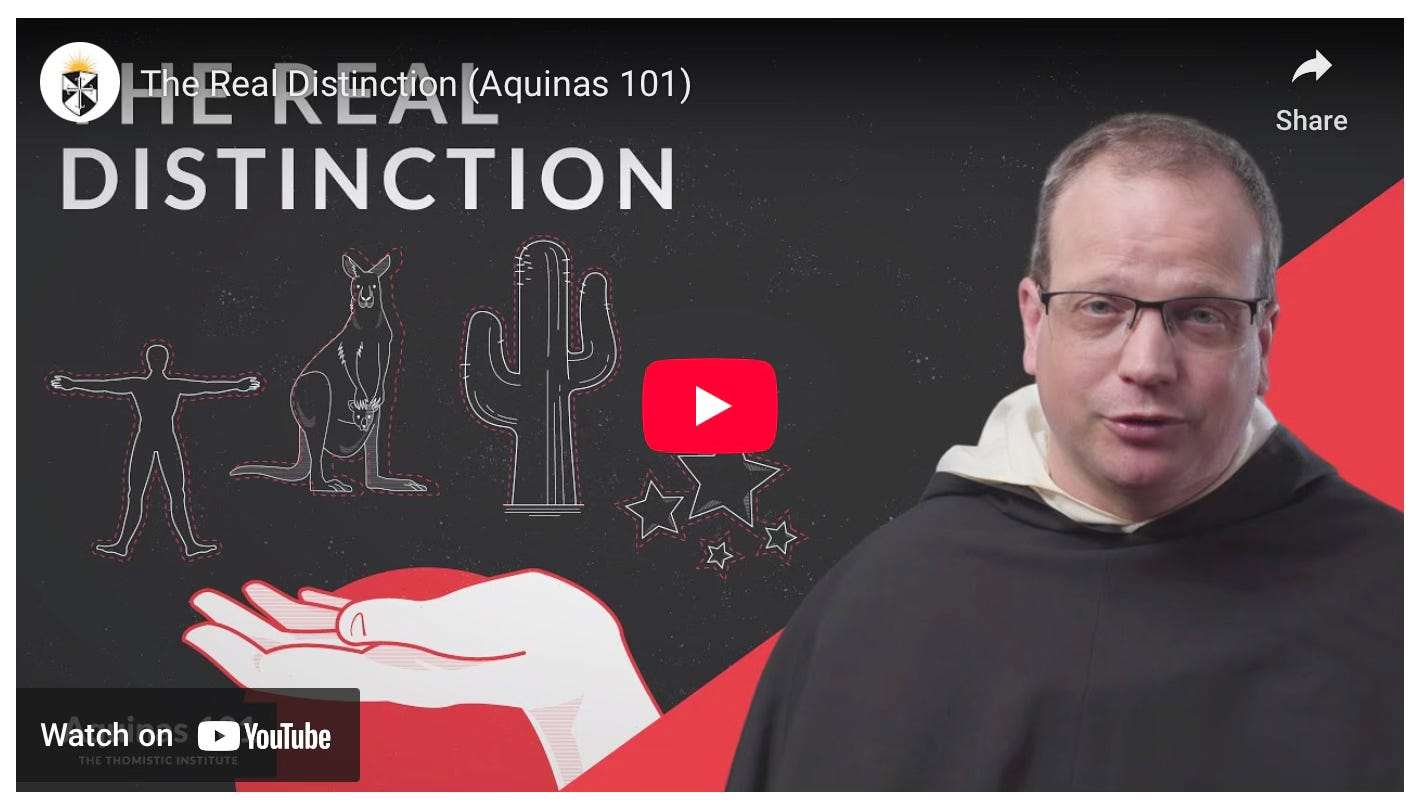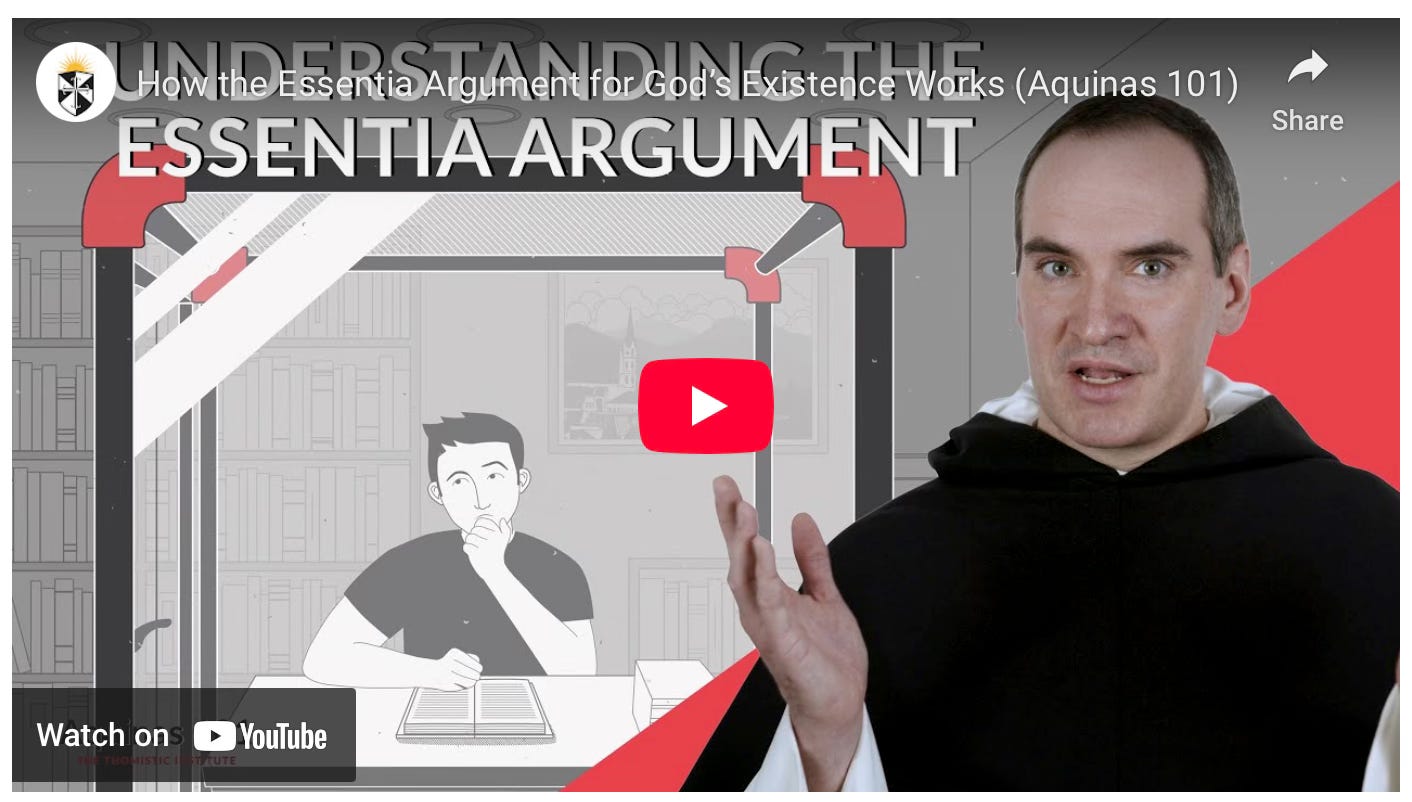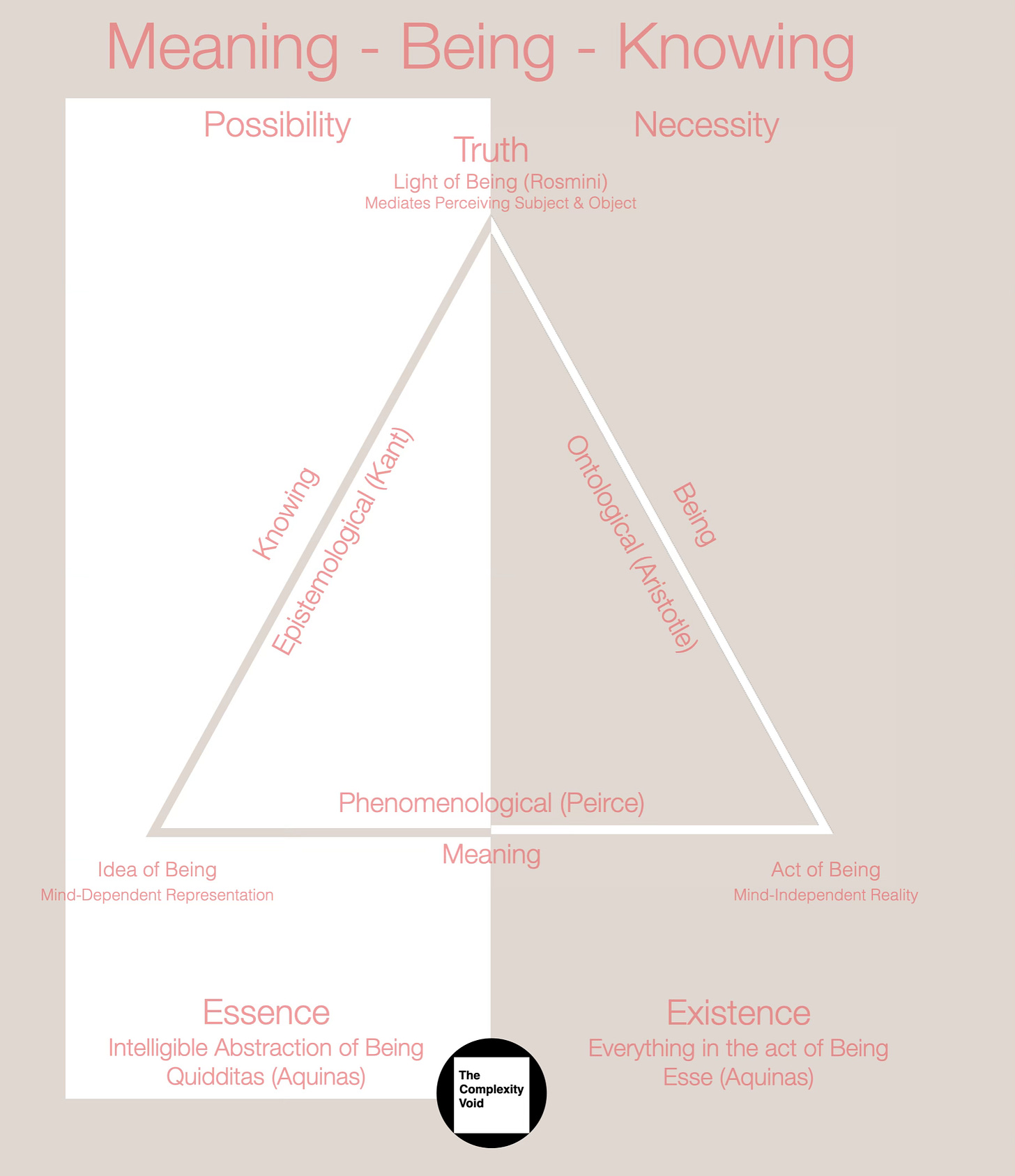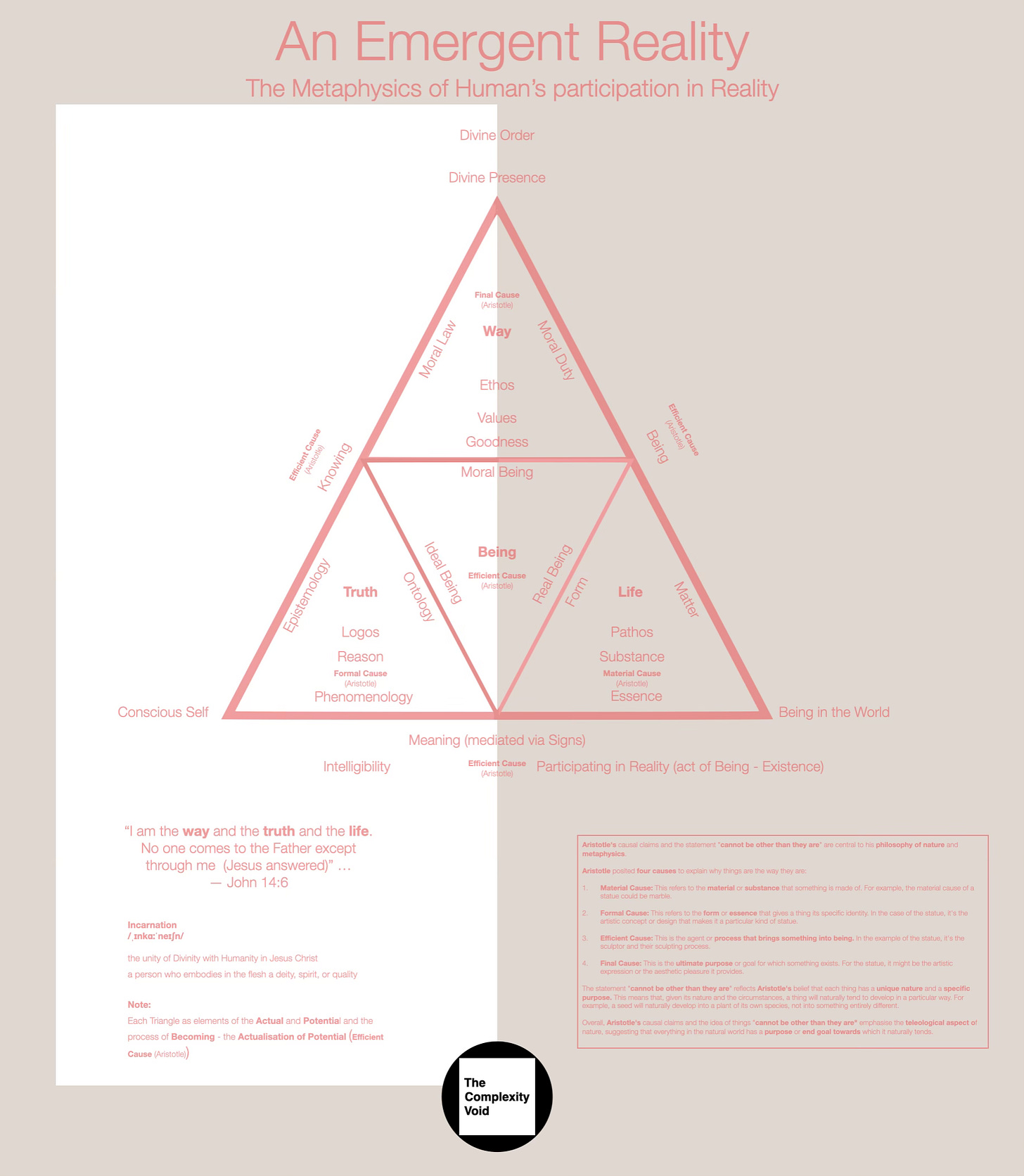The Real Distinction
Intelligibility, Thomism Metaphysics and a Divine Order
Photo by Ewan Song on Unsplash
“To one who has faith, no explanation is necessary. To one without faith, no explanation is possible”…
― St. Thomas Aquinas
In Presence and Difference - Property Dualism of Being and Human Consciousness [LINK] a critique of the prevailing Cartesianism philosophy was briefly explored.
An endemic Modern & Post-Modern belief system that can literally be traced back to the emergence of Modernism and ideas eminating from 16th-17th Century French Rationalist Philosopher Rene Descartes.
Descartes concluded that we cannot know the material world directly, not even through our bodies.
It is only through our ideas that represent the material world that we can know what exists recognising that God is not a deceiver.
In other words, certainty about the external world, requires God's existence as a guarantor of the truth of clear and distinct perceptions.
Cartesianism, the emergence of the Primacy of Human Consciousness and Primacy of Man (e.g. Theology of Marxism)
This distinction between the Human Mind and the Material World gives rise to Descartes making a substance ontological distinction (grounded in Liebniz Law (Identity of Indiscernibles)) between our Human Minds (res Cogitans) and Human Bodies (res Extensa) & broader material world.
A cartesian dualism that was pivotal in re-orientating Modern and Post-Modern Philosophical Intellectual inquiry towards a Primacy of Human Consciousness (e.g. Cartesianism, Gnosticism, Nietzschean Perspectivism, Nominalism, Umwelt) and the Primacy of Man (e.g. Theology of Marxism and Modern Gnosticism).
A Primacy of Human Consciousness [LINK] that can also be traced back to the schism [LINK] that emerged in Western Civilisation Christian Theology (e.g. Martin Luther), Philosophy and Metaphysics (e.g. William of Ockham).
An Anthropocentric re-orientation in Western Civilisation intellectual thought [LINK].
[LINK]
Presence and Difference: An Alternative Dualism - Mind Dependent Representation (i.e. Conscious Self - Ego) and Mind Independent Properties (i.e. Being)
Given the growing cognitive dissonance [LINK] that was emerging as Modernity progressed leading to a Crisis of Modernity [LINK] and Post-Modernity [LINK], an alternative understanding of the nature of Reality was required.
Presence and Difference - Property Dualism of Being and Human Consciousness [LINK] highlighted how intelligibility was firmly grounded in the act of Being (existence).
Rather than a Cartesian Substance Dualism grounded in the Primacy of Human Consciousness and the Human Mind, our Mind (Conscious Self - Ego) and Body (Being in the World) were interdependent and interconnected (Entangled).
A Mind Dependent Representation (i.e. Conscious Self - Ego) and Mind Independent Properties (i.e. Being) [LINK].
[LINK]
It was a recognition of the entangled nature of Being.
Both our Mind & Body but also this Being with every thing else in the act of Being.
A Social Contract between the past, present and future.
“Society is indeed a contract ... it becomes a participant not only between those who are living, those who are dead, and those who are to be born”…
― Edmund Burke
It was a recognition of the interplay between the Primacy of Human Consciousness [LINK] and Primacy of Existence [LINK] noting that our ideas have real world consequences.
It was a recognition that Being was the teological common ground of Divine and Natural Revelation [LINK].
It was a recognition of both the metaphysical and physical dimensions to Being - a Triadic Being (Rosmini - Real Being, Ideal Being and Moral Being) - Human Being [LINK].
It was a recognition of the Ontological Being - Imago Dei - Man created in the image of God [LINK].
It was a recognition of the Univocity of Being (the Highest Category of Human Thought) and the nexus between the Contingent Being of Man (Created) and the Necessary Being of God (Creator) [LINK].
It was a recognition of the “in-between” Metaxic Semiotic nature of Human Being [LINK] - the relationship between intelligibility and Meaning, Being & Knowing [ LINK].
Dyadic or Triadic structures of Reality?
Whilst Property Dualism begins to address some of the shortcomings of Cartesian Dualism by recognising that we are entangled in the World (i.e. our Minds (res Cogitans) & Body (res Extensa) are entangled in Real Being (Rosmini) and our participation in Reality) was it sufficient to metaphysically explain the nature of Reality?
Was the Primacy of Man (e.g. Theology of Marxism), the Primacy of Human Consciousness (e.g. Cartesianism, Nietzschean Perspectivism, Modern Gnosticism etc… ) and a Nietzchean liberation of Man (i.e. from God , from nature and from himself) symptomatic of Modern & Post-Modern Man’s attempt to sweep away the basic axioms of former ages (entering a Theatre of the Absurd)?
Was there an opportunity to revisit the work of Scholastic Theologians and Philosophers that were integrating Aristotelean Greek Philosophy and Christian Theology?
Aquinas: The Real Distinction - The Foundational Doctrine of Thomism Metaphysics
[LINK]
As outlined in Schism - The Anthropomorphism of Christian Theology, Philosophy and Metaphysics [LINK], the philosophical system of Saint Thomas Aquinas, known as Thomism [LINK] reflected such a synthesis.
[LINK]
It combined Christian Theology and the philosophy of Aristotle (Logic and Metaphysics) interpreted through a Metaphysical Realist Framework.
The intelligibility (via Reason) of the Universe reflected an Order of Things (i.e. God (Divine Being and Final Cause), Man (Rational Creature and Conscious Being) and Natural World (Created Order and Cosmos)).
In particular, his doctrine of The Real Distinction was not only central to his Thomism Philosophy, but was fundamental to our human understanding of the distinction between Man and God.
[LINK]
The Real Distinction between essence (what a thing is) and existence (that a thing is) is at the centre of Saint Thomas Aquinas’s metaphysics.
It is not merely a logical or conceptual difference but an ontological distinction in the very nature of Being.
Ideas that are central to the Intelligibility of Human Being [LINK].
For Aquinas, in all Finite Beings (i.e. the Created), essence and existence are distinct.
Their essence does not include existence; thus, they must receive existence from another.
This real composition makes them contingent, dependent, and capable of ceasing to be.
By contrast, in God alone (i.e. the Creator), essence is existence (ipsum esse subsistens - Being itself subsisting).
God is not merely a Being among others but is Being Itself, pure act (actus purus - pure actuality) without any potentiality or composition.
This distinction provides the metaphysical architecture that differentiates all creation from the creator.
This doctrine simultaneously grounds Aquinas’s understanding of the distinction between Man and God.
Man, like all creatures, has an essence that must be actualised by existence—he is not necessary, but contingent.
His Being is finite, mutable, and dependent.
By contrast, God is necessary, infinite, immutable, and self-sufficient.
Thus, the real distinction underpins the metaphysical difference between human and divine nature.
It affirms that man cannot be divine by nature but only by participation and grace.
Consequently, this doctrine not only structures Aquinas’s entire metaphysical framework but also preserves the Creator–Created distinction that is central to Christian theology.
Without it, the ontological hierarchy collapses, and with it, the coherence of Thomistic metaphysics.
In Aquinas’s realism metaphysical view, there was both an inseparable unity together with a distinction between essence and existence in finite beings.
An inseparability, where the essence ( a universal ) exists and the mind does not know things directly, but only indirectly through an abstraction of form via a sense of perception.
A distinction, where the essence of a thing is distinct from its existence (i.e. except for God) in the finite realm.
Conclusion
The important role of Aquinas’s doctrine of The Real Distinction illuminates the growing cognitive dissonance and Crisis of Modernity [LINK] and Post-Modernity [LINK].
Historical foundational ideas that enables us to recognise inter alia:
the distinction between essence and existence in Finite Being’s;
Being’s role in illuminating the intelligibility of truth and the Good (Aquinas);
the important role of epistemological humility, learning and open inquiry in actualising the potential of Being - the Breath of Being [LINK];
the pitfalls of retreating into a world of more and more abstraction where context collapses (e.g. increasing algorithmic governance of Society via computation). An abstract conceptual form of thinking (e.g. Heidegger- Vorhandenheit (Present-at-Hand)) that is a secondary derivative mode of encountering Being where practical involvement is disrupted. The entity becomes a conceptual object, something with properties, divorced from its contextual function;
the risks of the mathematisation of Nature [ LINK] that both Heidegger and Husserl highlighted as the drift in Modern Society;
an intelligibility (via reason) that recognises both a unity and at the same time a distinction between Essence, Form and Matter in a Substance (Aristotle) that exists (act of Being);
the Univocity of Being (Duns Scotus) between the Contingent Being of Man (Created) and Necessary Being of God (Creator);
the awe and wonder of creation (Human Being and Natural World);
the triadic metaphysical structures of Reality to bring a Sense of Coherence;
the crisis of Modernity and Post-Modernity grounded in a Theological, Philosophical and Metaphysical Anthropocentricity;
the distinction between the properties of the Human Mind (essence - quiddity) and Human Being (existence - esse) in the World (participation in the act of Being - this Being (Dasein) relationship with Being (Sein) - Heidegger); and
a Thomism Metaphysical Triadic relationship where the existence (everything in the act of Being - the material cause (Aristotle) ) — and the essence (the intelligibility - the formal cause (Aristotle)) are both orientated towards God and a Divine Order ( Purpose (Telos) and Final Cause (Aristotle)).
A return to a Thomism hierarchy and order of things where God is the ultimate source of the light of intelligibility and a Divine Order [LINK].
Footnote:
“92. Essence is found in a second way in created intellectual substances. Existence in them is other than their essence, although essence is without matter. Whence their existence is not absolute, but received, and therefore limited and confined to the capacity of the recipient nature. But their nature or quiddity is absolute, not received in any matter. And this is why it is said in the Book on Causes that the intelligences are unlimited from below and limited from above, for they are limited as regards their existence, which they receive from above; but they are not limited from below because their forms are not limited to the capacity of a matter receiving them”…
— Saint Thomas Aquinas, De Ente et Essentia
[LINK]
Note: A quote from Aquinas that captures that their Final Cause (Aristotle - Four Causes) in created intellectual substances - their Existence ( Esse ) — act of Being - is received from above - God. Hence, the intelligibillity ( Quidditas ) is also not received from matter but from existence - act of Being - God.
In other words:
Essence without existence is merely potential;
Existence (esse) is the actualising principle—received from God, who alone is ipsum esse subsistens (subsistent Being itself); and
Therefore, a creature's intelligibility and its purpose (final cause) are dependent upon and oriented toward the divine act of Being.
“20. Reason, too, is in accord with this, because the existence of a composed substance is not the existence of the form alone nor of the matter alone, but of the composite itself; and essence is that according to which a real thing is said to be. Whence it is necessary that the essence, whereby a real thing is denominated a being, be neither the form alone nor the matter alone, but both, although the form alone in its own way is the cause of such existence”…
— Saint Thomas Aquinas, De Ente et Essentia
[LINK]
Schism
"Triumph of the Franciscan Order" by Baciccio (1707) in the Basilica of Santi Apostoli in Rome, Italy” - Courtesy of Nick Castelli on Unsplash












